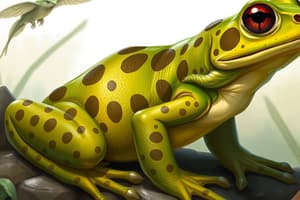Podcast
Questions and Answers
Which class of tetrapods shows a transition from aquatic to terrestrial habitat?
Which class of tetrapods shows a transition from aquatic to terrestrial habitat?
- Class Reptilia
- Class Mammalia
- Class Amphibia (correct)
- Class Aves
Which class of vertebrates descended from a stem reptile called 'cotylosaurs'?
Which class of vertebrates descended from a stem reptile called 'cotylosaurs'?
- Class Reptilia (correct)
- Class Aves
- Class Mammalia
- Class Amphibia
Which class of vertebrates is characterized by the presence of hair and mammary glands?
Which class of vertebrates is characterized by the presence of hair and mammary glands?
- Class Aves
- Class Reptilia
- Class Mammalia (correct)
- Class Amphibia
What is a key characteristic of Class Aves that distinguishes them from other classes mentioned in the text?
What is a key characteristic of Class Aves that distinguishes them from other classes mentioned in the text?
Which class of vertebrates has cold-blooded aquatic or terrestrial tetrapods with scaly skin or bony plates?
Which class of vertebrates has cold-blooded aquatic or terrestrial tetrapods with scaly skin or bony plates?
Which class is characterized by the presence of hair, mammary glands, and adaptive radiation to various habitats?
Which class is characterized by the presence of hair, mammary glands, and adaptive radiation to various habitats?
Which class of warm-blooded vertebrates is considered as the glorified reptiles?
Which class of warm-blooded vertebrates is considered as the glorified reptiles?
What characteristic of Class Mammalia distinguishes Subclass I.Prototheria from Subclass II.Theria?
What characteristic of Class Mammalia distinguishes Subclass I.Prototheria from Subclass II.Theria?
Which subclass of birds includes modern birds with reduced wing bones?
Which subclass of birds includes modern birds with reduced wing bones?
What is a common feature between Superorder III.Neognathae and Class Aves?
What is a common feature between Superorder III.Neognathae and Class Aves?
What is the Superorder that includes extict toothed birds like Hesperornis regalis and Ichthyornis victor?
What is the Superorder that includes extict toothed birds like Hesperornis regalis and Ichthyornis victor?
Which class in the text includes species considered as glorified reptiles due to their reptilian origin?
Which class in the text includes species considered as glorified reptiles due to their reptilian origin?
What is a characteristic of Class Aves?
What is a characteristic of Class Aves?
Which order in Class Amphibia is characterized by well-developed limbs adapted for leaping and swimming?
Which order in Class Amphibia is characterized by well-developed limbs adapted for leaping and swimming?
Which feature distinguishes Class Mammalia from other classes mentioned in the text?
Which feature distinguishes Class Mammalia from other classes mentioned in the text?
What evolutionary process led to the development of Class Aves according to the text?
What evolutionary process led to the development of Class Aves according to the text?
From which stem reptile did Class Reptilia descend according to the text?
From which stem reptile did Class Reptilia descend according to the text?
What distinguishes Class Amphibia from other classes mentioned in the text?
What distinguishes Class Amphibia from other classes mentioned in the text?
Flashcards are hidden until you start studying
Study Notes
Tetrapod Transition
- The transition from aquatic to terrestrial habitat is shown by the class Amphibia.
Descendants of Cotylosaurs
- The class Reptilia descended from a stem reptile called 'cotylosaurs'.
Characteristics of Mammalia
- The class Mammalia is characterized by the presence of hair and mammary glands.
- Hair, mammary glands, and adaptive radiation to various habitats are characteristic features of the class.
Characteristics of Aves
- A key characteristic of Class Aves is that they are warm-blooded vertebrates.
- Feathers are a characteristic feature of Class Aves.
- The Superorder III.Neognathae and Class Aves share the common feature of having keel-shaped breastbones.
Characteristics of Reptilia
- The class Reptilia is characterized by cold-blooded aquatic or terrestrial tetrapods with scaly skin or bony plates.
- The class Reptilia is considered as the glorified reptiles.
Characteristics of Amphibia
- The class Amphibia includes species that are cold-blooded aquatic or terrestrial tetrapods with smooth, moist skin.
- The order Anura in Class Amphibia is characterized by well-developed limbs adapted for leaping and swimming.
- The class Amphibia is distinguished from other classes mentioned in the text by their ability to undergo metamorphosis.
Evolutionary Process
- The evolutionary process that led to the development of Class Aves was adaptive radiation.
- The class Reptilia descended from a stem reptile called 'cotylosaurs'.
- The class Aves evolved from a group of reptiles called theropods.
Studying That Suits You
Use AI to generate personalized quizzes and flashcards to suit your learning preferences.




